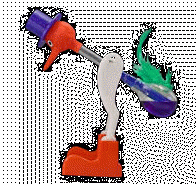|
Momentum - Part I
Objectives
• Know that all massive objects have momentum when in
motion.
• Be able to calculate the momentum of a moving object
using the formula p = m × v
• Be able to find the change in momentum of an object,
given information about its velocity.
Task 1 - Starter
1. Watch this video of a tennis ball hitting the floor.
Think about the energy changes that took place, from the point the ball
was released to the point it rebounds. Discuss your ideas with the
person next to you and draw an energy transfer diagram to show what
happens.
2. A small rubber ball of mass 9.0g is dropped from a
height of 1.25m, and lands on the ground.
| • Calculate the
change in GPE. • State the KE
of the ball at the instant it hits the floor.
•
Calculate the velocity it will be travelling at this point.
• State how you would expect the
velocity of rebound to compare to the velocity of impact. Give
reasons for your answer.
|
Select the correct formulae from the equation sheet.
Use g = 10 N kg-1.
Task 2
| Watch as your teacher
demonstrates a sad (inelastic) ball being dropped. What
happens when the ball strikes the table? |
 |
|
Before
collision |
After
collision |
|
 |
 |
Momentum is
a useful quantity to help us determine the outcome of collisions. The ball
gained momentum
as it fell. When it struck the table there was a sudden change
in momentum. We can calculate the momentum of the ball at any
point using the formula:
|
p =
m × v
|
p =
momentum, measured in Newton-seconds (N
s or kg m/s
or kg ms-1).
m = mass, measured
in kilograms (kg).
v = velocity,
measured in metres per second (m/s
or ms-1). |
|
Your teacher will give you a
copy of the diagrams and formula above.
Calculate :
• The momentum of the ball
before the collision.
• The momentum of the ball after the collision.
• The change of momentum of the ball.
• Is the change in momentum positive or negative?
(Hint: is momentum lost or gained by the ball?)
|
Write your answers in the space on the sheet,
and show full working for the calculations.
Task 3
Watch as your teacher drops the happy (elastic) ball.
The ball is the same mass, and it is dropped from the same height.
It bounces back at approximately the same speed it hits the ground.
Think about:
• Which quantities are different this time?
• Which quantities are the same?
• What is the momentum of the ball before the
collision?
• What is the momentum of the ball after the
collision?
• Will the change of momentum be bigger
or smaller than the sad ball?

Repeat the calculations for the happy (elastic) ball.
Write your answers in the space on the sheet, and
show full working for the calculations.
|
Extension /
MAT work:
The happy ball
does not actually bounce back at the same speed. It
has a coefficient of restitution of 0.75,
meaning it will bounce back to 75% of the drop height.
Work out:
1. What
height it will reach after bouncing.
2. What
velocity it must have left the ground in order to reach this
height.
3. What
the change of momentum is, using your new value for
velocity.
4.
Assuming the bounce takes approximately 0.1 seconds,
calculate:
a) The acceleration of the ball as it undergoes the
change in direction.
b) The force exerted on the ball by the table.
|
Teacher note:
The extension / MAT work is available
here as a word document.
Task 4
Use the ideas from the work above, and the formula you
have learned to solve
these problems. Answer the questions in your exercise book and
show full working for all calculations.
|

